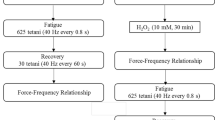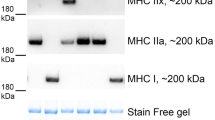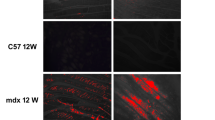The molecular mechanism of violation of the contractile function of skeletal muscles caused by oxidative damage to myosin is not fully understood. Using permeabilized fibres from fast (m. psoas) and slow (m. soleus) rabbit muscles, we studied the effect of myosin oxidation on the mechanism of force generation and its calcium regulation. It was found that this treatment simultaneously reduces the maximum force and fibers stiffness without affecting their calcium sensitivity. This suggests that the mechanism of oxidation-related impairment the force-generating ability of fibers consists in suppression of myosin cross-bridges formation and does no affect the characteristics of actin—myosin interaction.
Similar content being viewed by others
References
Andrade FH, Reid MB, Allen DG, Westerblad H. Effect of hydrogen peroxide and dithiothreitol on contractile function of single skeletal muscle fibres from the mouse. J. Physiol. 1998;509(2):565-575.
Bershitsky SY, Tsaturyan AK. The elementary force generation process probed by temperature and length perturbations in muscle fibres from the rabbit. J. Physiol. 2002;540(3):971-988.
Chang CC, Yang MH, Tung HC, Chang CY, Tsai YL, Huang JP, Yen TH, Hung LM. Resveratrol exhibits differential protective effects on fast- and slow-twitch muscles in streptozotocininduced diabetic rats. J. Diabetes. 2014;6(1):60-67.
Dalle-Donne I, Rossi R, Giustarini D, Milzani A, Colombo R. Protein carbonyl groups as biomarkers of oxidative stress. Clin. Chim. Acta. 2003;329(1-2):23-38.
Dutka TL, Verburg E, Larkins N, Hortemo KH, Lunde PK, Sejersted OM, Lamb GD. ROS-mediated decline in maximum Ca2+-activated force in rat skeletal muscle fibers following in vitro and in vivo stimulation. PLoS One. 2012;7(5):e35226. doi: https://doi.org/10.1371/journal.pone.0035226.
Gross SM, Lehman SL. Accessibility of myofilament cysteines and effects on ATPase depend on the activation state during exposure to oxidants. PLoS One. 2013;8(7):e69110. doi: https://doi.org/10.1371/journal.pone.0069110.
Lamb GD, Posterino GS. Effects of oxidation and reduction on contractile function in skeletal muscle fibres of the rat. J. Physiol. 2003;546(1):149-163.
Lamb GD, Westerblad H. Acute effects of reactive oxygen and nitrogen species on the contractile function of skeletal muscle. J. Physiol. 2011;589(9):2119-2127.
Murphy RM, Dutka TL, Lamb GD. Hydroxyl radical and glutathione interactions alter calcium sensitivity and maximum force of the contractile apparatus in rat skeletal muscle fibres. J. Physiol. 2008;586(8):2203-2216.
Plant DR, Lynch GS, Williams DA. Hydrogen peroxide modulates Ca2+-activation of single permeabilized fibres from fastand slow-twitch skeletal muscles of rats. J. Muscle Res. Cell Motil. 2000;21(8):747-752.
Prochniewicz E, Lowe DA, Spakowicz DJ, Higgins L, O’Conor K, Thompson LV, Ferrington DA, Thomas DD. Functional, structural, and chemical changes in myosin associated with hydrogen peroxide treatment of skeletal muscle fibers. Am. J. Physiol. Cell Physiol. 2008;294(2):C613-C626.
Zergeroglu MA, McKenzie MJ, Shanely RA, Van Gammeren D, DeRuisseau KC, Powers SK. Mechanical ventilationinduced oxidative stress in the diaphragm. J. Appl. Physiol. (1985). 2003;95(3):1116-1124.
Yamada T, Mishima T, Sakamoto M, Sugiyama M, Matsunaga S, Wada M. Oxidation of myosin heavy chain and reduction in force production in hyperthyroid rat soleus. J. Appl. Physiol. (1985). 2006;100(5):1520-1526.
Author information
Authors and Affiliations
Corresponding author
Additional information
Translated from Byulleten’ Eksperimental’noi Biologii i Meditsiny, Vol. 166, No. 8, pp. 136-140, August, 2018
Rights and permissions
About this article
Cite this article
Kochubei, P.V., Kopylova, G.V., Shchepkin, D.V. et al. Hydrogen Peroxide Treatment of Muscle Fibres Inhibits the Formation of Myosin Cross-Bridges. Bull Exp Biol Med 166, 183–187 (2018). https://doi.org/10.1007/s10517-018-4310-8
Received:
Published:
Issue Date:
DOI: https://doi.org/10.1007/s10517-018-4310-8




